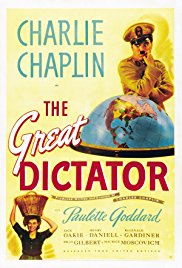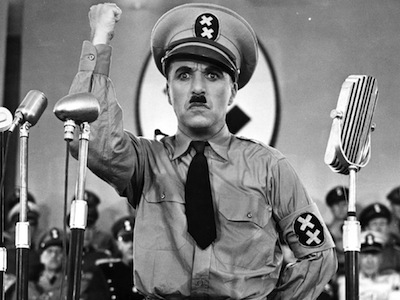THE GREAT DICTATOR
SUBJECTS — Biography/Hitler; World/WWII.
AGE: 10+; MPAA Rating: G;
Satire; 1941; 126 minutes; B & W. Available from Amazon.com.
There is NO AI content on this website. All content on TeachWithMovies.org has been written by human beings.

SUBJECTS — Biography/Hitler; World/WWII.
AGE: 10+; MPAA Rating: G;
Satire; 1941; 126 minutes; B & W. Available from Amazon.com.
“The best Chaplin movie ever!” said a ten-year-old World War II buff. The names indicate the fun in store for anyone who sees this film:

Chaplin plays Hynkel, a dictator with a “Charlie Chaplin moustache” who looks and acts like Hitler. Chaplin also plays a Jewish barber who was a hero in the “Tomanian” Army during the previous war (World War I) and who looks exactly like Hynkel.
This movie is a farce but the last speech is quite serious.
The humor in this film will be appreciated most by children who have a basic understanding of World War II and of the threat to Western Civilization posed by Hitler, Mussolini, Göebbels, and Göring.

Selected Awards: 1940 National Board of Review Awards: Ten Best films of the Year; 1940 New York Film Critics Award: Best Actor (Chaplin); 1940 Academy Awards Nominations: Best Picture, Best Actor (Chaplin), Best Supporting Actor (Oakie), Best Original Screenplay, Best Original Score. This film is listed in the National Film Registry of the U.S. Library of Congress as a “culturally, historically or aesthetically significant” film. This film is ranked #37 on the American Film Institute’s List of the 100 Funniest American Movies of All Time (2006).
Featured Actors: Charles Chaplin, Paulette Goddard, Jack Oakie, Billy Gilbert, Reginald Gardiner, Henry Daniell, Maurice Moscovitch.
Director: Charles Chaplin.
This movie makes history hilarious. It will confirm the understanding of the events leading up to WWII for those children who already have a background in the history of that time. The film also contains sequences of great humor and poetry. The scene with Hitler and the globe is one of the most memorable on film. “The Great Dictator” will provide an opportunity for parents or teachers to explain many of the events leading up to World War II and the personalities of the men who started the war.
MINOR. The scenes of the concentration camp are naively benign. When this movie was made most people in the United States did not know about the actual conditions in the concentration camps or that the German government planned to murder millions of people. Children watching this film should be told that the concentration camps were much worse than they are depicted in this film. The actual conditions in the camps, why Chaplin didn’t know about them, and who actually did know about the treatment of the Jews and other prisoners are good topics for discussion.
If your child knows a lot about WWII, and the monstrous crimes perpetrated by Hitler and those around him, tell him or her that this movie was made in 1941 before the U.S. entered WWII and when Nazi atrocities were not known in the U.S., For example, the portrayal of concentration camp in this movie does not show their horror. Charlie Chaplin was Jewish and very left-wing, if not a Communist. He hated everything Hitler stood for. To add insult to injury, Hitler copied the Little Tramp’s moustache.
If your child doesn’t know a lot about WWII, describe to them the brutal atrocities committed by the killers ridiculed in this film and how they claimed to be statesmen and the proponents of a new order in the world. As Chaplin points out, they were just thugs.
Ask and help your child to answer the Quick Discussion Question.
Adolf Hitler (Adenoid Hynkel in the film) was born in Austria and became the dictator of Germany in 1933. In addition to being a mass murderer and sociopath, he was a political genius, a powerful orator and one of the first politicians to understand and exploit the mass media. His Nazi party fomented a radicalism of the right which won mass support, beating the socialists and Communists on their own ground. He had a maniacal hatred of the Jewish people. Hitler launched World War II by invading Poland in 1939. Under Hitler, German armies conquered more of Europe than did Napoleon. In 1945, with Russian troops closing in on Berlin, Adolf Hitler committed suicide in his bunker.
After the First World War, the Allies imposed onerous peace terms on Germany. These terms included: the loss of territory, the loss of colonies, the payment of vast sums as war reparations, and restrictions on German sovereignty. Most Germans found these terms humiliating. During the 1920s and early 1930s, Germany suffered severe inflation and high unemployment. Its democratically elected governments could not cope with these problems. Adolf Hitler and the Nazi party capitalized on the humiliation Germans felt over the terms of the armistice and the disastrous economic situation. During the 1930s Hitler stabilized the economy, put people back to work and restored German pride. He also re-armed the country.
Benito Mussolini (Benzino Napaloni in the film) was the fascist dictator of Italy from 1924 to 1943. The fascist program was a blend of nationalism and socialism. Under Mussolini, Italy brutally conquered Ethiopia in 1935 – 1936 and annexed Albania in 1939. For a time, Mussolini was in competition with Hitler, but soon he was overshadowed because Germany was stronger militarily than Italy. It is the period of competition between Hitler and Mussolini which the film examines.
In 1940 Italy joined with Germany and Japan to form the Axis Powers. The Italian armies suffered defeats in Greece, Africa and at home. In the end, Mussolini was reduced to heading a German occupied puppet state. He was caught by Italian Partisans and shot in 1943.
Paul Joseph Göebbels (Garbitsch in the film) was the Nazi propaganda chief and one of Hitler’s closest lieutenants. He organized Nazi political campaigns and skillfully used the mass media to further the Nazi cause. He committed suicide with his family in Berlin in 1945.
Hermann Wilhelm Göring (Herring in the film) organized the Gestapo and, as commander of the German Air Force, prepared the aerial Blitzkrieg campaigns of the Second World War. His power in Germany dwindled when he was unable to stop Allied air attacks. He was convicted of war crimes at the Nuremberg trials and poisoned himself in his prison cell in 1946.
The Nazis employed young men in strong-arm gangs, called Storm Troopers, to intimidate their political opponents and Jews. The Brown Shirts, as they were also called, grew into a private army for the Nazi party.
The reference in the movie to borrowing money from a Jewish banker to finance the war refers to a practice among European monarchs in the 17th and 18th and 19th centuries. When they needed money to finance wars, they would at times borrow the funds from consortia of Jewish bankers.
The sign of the Nazi party was the swastika. It has become a symbol of hatred and intolerance. In the movie, the sign of Hynkel’s party is the “double-cross” which looks very much like a dismembered swastika.
The vast majority of German Jews were patriotic German citizens. Thousands fought on the German side in the First World War. Many were wounded in battle and many were decorated for valor. The Jewish barber was one of these wounded war heroes.
Approximately 12 million people were killed in German concentration camps during World War II. Half of these were Jews. The other six million were Democrats, socialists, Communists, gypsies, the disabled, the religious and anyone who dared to oppose Hitler. The Germans hid what they were doing in the concentration camps from the outside world. The horrific conditions of these camps were not generally known in the Allied countries during the war.
The Nazi party was a proponent of the theory that there was one race of people who were better than all others. They called this the “Aryan race” although the term “Aryan” properly refers to the family of languages known as “Indo-European.” In Nazi propaganda, the “Aryan” race was typified by Nordic, blond haired and blue eyed people. Ironically, Hitler had dark hair and brown eyes. As Garbitsch predicts, Hynkel will rule the world after “wiping out the Jews [and] then the brunettes.” See also the classroom scene in Europa! Europa!.
List four names that Chaplin used to ridicule Hitler, Germany or the fascists.
Suggested Response:
See Description Section above.
1. See Discussion Questions for Use With any Film that is a Work of Fiction.
2. What did Chaplin want to tell us by having the “double cross” as the symbol of Hynkel’s political party?
3. Would you have tried to resist Hitler if you had lived in Germany in 1940? What do you think would have happened to you? What could you have done?
4. How much of this movie is Chaplin taking revenge upon Hitler for copying his moustache?
Nazi, Storm Trooper, Brown Shirt, swastika, “concentration camp,” fascist.
Any World War II movie, e.g., Judgment at Nuremberg and Europa! Europa!